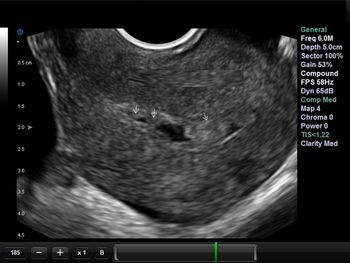
New research shows that babies born to mothers who exercised during pregnancy have more mature brains than babies whose mothers did not exercise.

New research shows that babies born to mothers who exercised during pregnancy have more mature brains than babies whose mothers did not exercise.

Outpatient hysteroscopic metroplasty with bipolar electrode is an effective treatment in patients with infertility related to septate uterus.

Data show that maintaining surgical proficiency results in better outcomes for laparoscopic hysterectomy. The magic number for maintenance: 20 procedures a year.

Non-white women with low levels of vitamin D are more likely to deliver preterm than white mothers, according to a new study in the American Journal of Epidemiology.

More than 30% of injuries during robotic surgery are related to operator error or robot failure but the majority of problems are not associated with the technology. So says a retrospective review of complications of robotic surgery reported to the US Food and Drug Administration (FDA) Manufacturer and User Facility Device Experience (MAUDE) database. The findings were presented at the 42nd AAGL Global Congress on Minimally Invasive Gynecology in Washington, DC.

Panelists Leila V. Adamyan, MD, Alan H. DeCherney, MD, and Linda M. Nicoll, MD, went 1 for 2 during the “Stump the Professors” session at the 42nd AAGL Global Congress on Minimally Invasive Gynecology in Washington, DC.

Female providers were twice as likely as their male counterparts to order HPV testing for low-risk women aged 30 to 65 who had normal Pap smear results.

What is your diagnosis based on these images from a young woman with irregular menses?

Women overall know little about urinary incontinence and pelvic organ prolapse, but the knowledge gap is greater for non-white women, survey results show.

The risk of endometriosis is 30% to 70% higher in women exposed to the organochlorine pesticides beta-hexachlorocyclohexane and mirex, new research finds.

All pregnant women should be tested for diabetes by 13 weeks’ gestation and tested again for gestational diabetes between 24 and 28 weeks’ gestation, say new guidelines.

Young women in the South lag behind their counterparts in other regions around the US when it comes to human papillomavirus (HPV) vaccination, according to a recent study in Vaccine.

Six states received an “A” grade on the March of Dimes’s 2013 Premature Birth Report Card but the country overall achieved only a “C.” That is despite a drop in rates of preterm birth for the sixth consecutive year.

Using acetaminophen during pregnancy may not be as risk-free as previously thought, according to a recent study in International Journal of Epidemiology of the drug’s impact on neurodevelopment.

Patients with uterine fibroids have been advised to avoid a hysterectomy as treatment of the condition at all costs. Sound advice or mucky water?

A new study has shown that acetaminophen use in pregnancy may be associated with neurodevelopmental adverse effects in the offspring of women who used the drug.

What is your diagnosis based on these images from a 35-week fetus?

The effectiveness of lamotrigine for bipolar disorder decreases during pregnancy and requires upward dose adjustments until delivery to avoid symptom recurrence.

Lowering the cost of health care requires lowering the cost of medical education, a new perspective suggests.

An ob/gyn continues to fill prescriptions for HRT despite a patient's breast cancer diagnosis.

Three IVF experts discuss what policy is best for infertility patients.

A small percentage of abortions in the United States are performed in the second trimester. Patients should be informed of medical and surgical options.

The Foley balloon is a tried and true mechanical method for cervical ripening

Academic medicine is facing a funding crisis that's going to take some creativity to resolve.

A new survey reveals that the public is misinformed about the causes and prevalence of miscarriage.

Women should not feel that they need to log long hours of vigorous exercise to see any benefits, says a study from Spain.


In an adolescent, polycystic ovary syndrome should be diagnosed cautiously. The typical symptoms of PCOS in an adult may just be developmental irregularities in a teen.

Four new definitions of “term pregnancy” have been issued by The American College of Obstetricians and Gynecologists (ACOG) and the Society for Maternal-Fetal Medicine (SMFM) in a joint Committee Opinion. Published in the November issue of Obstetrics & Gynecology, the terminology is designed to put the focus on preventing deliveries before 39 weeks’ gestation.

Uterine fibroids can have a significant impact on the health, workplace performance and quality of life of women-particularly African-American women-according to a new study published in the American Journal of Obstetrics and Gynecology.